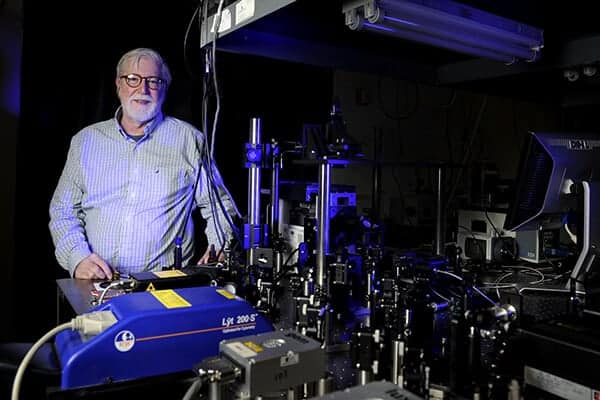Consider: You’ve always thought that the only way to travel from northern New Jersey to New York City was over the Hudson River via the George Washington Bridge. Then one day there’s a news flash: The Lincoln Tunnel through the Hudson is actually much more efficient.
Northeastern professor Paul Champion and his colleagues have made a comparable discovery deep in the subatomic world of protons, the positively-charged particles found in the nucleus of every atom.
The paper was published Wednesday in the journalNature Chemistry. Science magazine, struck by the results, highlighted it in its “Editor’s Choice” column upon its publication online.
Protons play a major role in many biochemical systems critical to sustaining life, including photosynthesis and cellular respiration—the process by which cells release the energy stored in the chemical bonds of food molecules.
Classical physics posits that protons travel over thermodynamic barriers—that is, they hopscotch from one molecular compound to another within a system, sparking those biochemical reactions only when the temperature is high enough to kick them over the barrier.
Now Champion’s team—using an ultrafast pulsed laser system designed at Northeastern—has revealed that protons can actually tunnel through those barriers, even at room temperature, sparking the reactions at a much faster rate than would be possible if they waited to be thermally kicked over the barrier.
The discovery upends the understanding held for centuries of protons’ behavior as well as of the compounds involved in their transport. The next step is for researchers to mimic the behavior in the lab and then use it to develop new technologies. For example, tunneling could help transport protons across a membrane and lead to new types of batteries. In fact, certain types of biologically inspired batteries are already in the pipeline.
These environmentally clean rechargeable batteries are modeled after mitochondria, the energy factories of animal and plant cells. Just as mitochondria convert glucose, a simple sugar, into adenosine triphosphate at room temperature to power living cells, bio-batteries, when perfected, could convert the energy stored in glucose to power devices from laptops to cars.
“Biology can serve as an inspiration for the materials that researchers are trying to create,” says Champion, chair of the Department of Physics. “Mitochondria are nature’s own highly evolved battery system, and the currency of that battery system is protons. We found that protons tunnel incredibly fast at room temperature to move from one point to another. Indeed, that is their dominant mode of transport. It was a very, very surprising result.”
Making a quantum leap
The team’s novel understanding of how a proton operates underlies the tunneling capability: Rather than functioning as simply a particle, hopping over Point A to reach Point B, according to classical physics, the proton also functions as a wave, puncturing Point A to reach Point B, in line with quantum physics.
“At first we weren’t sure what we were seeing,” says Champion. “And then we finally realized the protons were tunneling at room temperature. The process was remarkably fast—so much faster than over-the-barrier classical transport. We were shocked.”
For their experiment, the researchers turned to a protein called green fluorescent protein, or GFP, as a model system. GFP, first seen in the jellyfishAequorea victoria, is commonly used as a marker in biomedical research because it emits a green glow. By inserting DNA from GFP into other proteins, researchers can follow GFP’s colorful glow to track processes from nerve cell growth to cancer progression.
“The elements comprising GFP are well known,” says Bridget Salna, the paper’s first author and a doctoral student in physics. “The protons move internally a short distance in one direction and then they move back, among just four elements.” They are: three compounds—a glutamic acid, a serine, and a water—and the chromophore, which determines the green color. The proton’s journey, says Salna, is what sets off the green glow.
The researchers used light from their custom-designed lasers to trigger the proton-transport process, expectantly watching the particles’ travels over broad time and temperature scales.
“By narrowing down the duration of the pulse we could actually see and track the molecular dynamics over the entire cycle,” says Salna, PhD’17. “It was fascinating.”
Among those recognizing the breakthrough was Martin Karplus, winner of the 2013 Nobel Prize in Chemistry with Michael Levitt and Arieh Warshel. “It certainly makes clear the importance of ‘deep tunneling’ in proton transfer reaction at room temperature,” Karplus wrote in an email to Champion. “Congratulations!”


